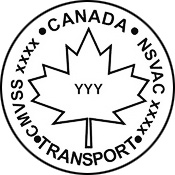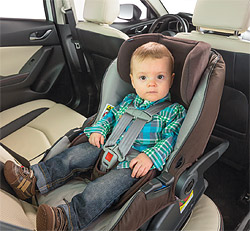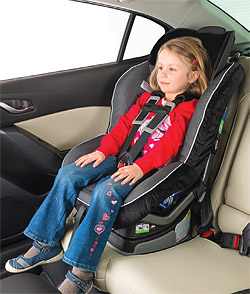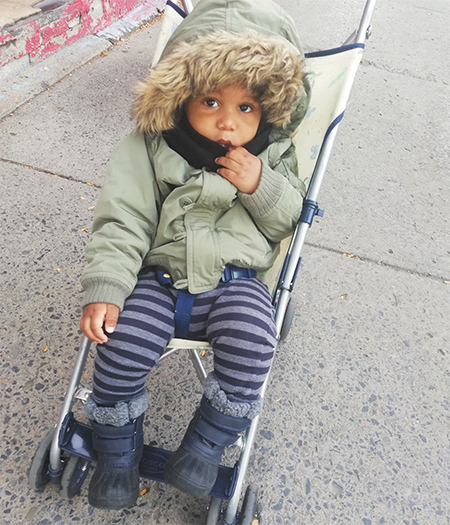Travelling safely
Correction: Please note that in the 2020 printed edition of the From Tiny Tot to Toddler guide, there was an error in the second bullet point on page 678. The text should say “The harness straps must go through the slots in the back of the seat at the height of your child’s shoulders or a little higher,” and not “a little lower,” as written. This information is important to ensure the optimal safety of children in forward-facing car seats. This information has been corrected on this page and the PDF versions. To receive a copy of the corrected page please contact [email protected].
In the car: Car seat
![]() In Québec, it’s mandatory to use a car seat for all car travel with your child.
In Québec, it’s mandatory to use a car seat for all car travel with your child.
An appropriate car seat, when used properly, can reduce the risk of death and injury by 70% in the event of a collision.
Car seat use is divided into three consecutive phases, starting from the birth of your child and changing with weight and age. The phases are presented below in the How to install a car seat and secure your child section.
Types of car seats
The type of car seat you should use depends on your child’s weight and height.There are four types of children’s car seats:
There are four types of children’s car seats:
- Infant car seats used from birth until around 10 kg (22 lb.).
- Child seats for children who weigh around 10 kg (22 lb.). Most child seats go up to 29.5 kg (65 lb.).
- Booster seats for children who weigh at least 18 kg (40 lb.). Booster seats are mandatory for children up to 145 cm in height or 9 years of age.
- Convertible seats, which can be used from birth and during the three phases described in the How to install a car seat and secure your child section.
Where to install a car seat in a vehicle
![]() For your child’s safety, his car seat must always be installed on the back seat of the vehicle.
For your child’s safety, his car seat must always be installed on the back seat of the vehicle.
Your child should always sit in the back seat until age 13.
Good to know...
If you need to sit your child in the front seat due to exceptional circumstances (e.g., the vehicle has no back seat or your child has a health issue that requires close supervision), you must first submit an airbag deactivation application to the Société de l’assurance automobile du Québec (SAAQ).
For more information, go to saaq.gouv.qc.ca/en/road-safety/modes-transportation/automobile/safety-devices/airbags/deactivation.
Car seat direction
Rear-facing car seats: as long as possible

For safety reasons, Transport Canada recommends children stay rear facing for as long as possible. This position provides better protection for their spinal column and brain in the event of a collision.
![]() In Quebec, use of a rear-facing seat is recommended until your child is at least two years of age.
In Quebec, use of a rear-facing seat is recommended until your child is at least two years of age.
Your child should stay rear facing until he reaches the car seat manufacturer’s recommended weight and height limits, even if his legs are bent. There must be a space of at least 2.5 cm between the top of the child’s head and the top of the seat.
Good to know...
Convertible seats can generally be used in the rear-facing position longer than regular child car seats (up to age 4, on average).
Front-facing car seats
If your child becomes too tall or heavy for his rear-facing seat (see owner’s manual for height and weight limits), he can switch to a forward-facing seat. Depending on his weight and height, your child may use a child car seat, a convertible seat in child car seat mode, or a booster seat.
Booster seats and convertible seats used as booster seats must always face forward.
How to install a car seat and secure your child
![]() Read the manufacturer’s instructions very carefully before putting your child in a car seat.
Read the manufacturer’s instructions very carefully before putting your child in a car seat.
To properly secure your child in his seat, you’ll need to consider the type of seat and the direction it faces (front or rear). Car seat use is divided into three consecutive phases, starting with the birth of the child.
Phase 1

Photo: Société de l’assurance automobile du Québec
![]() In Quebec, use of a rear-facing seat is suggested until your child is at least two years of age.
In Quebec, use of a rear-facing seat is suggested until your child is at least two years of age.
Types of seats: Infant seat, child seat or convertible seat (see Types of car seats)
Direction: Facing the rear of the vehicle
Installation:
- The harness straps must go through the slots in the back of the seat at the height of your child’s shoulders or a little lower.
- The chest clip connecting the two harness straps must be placed at armpit level (middle of your child’s chest).
- The harness straps must be tightened as close as possible to your child’s body. Don’t leave more than a finger’s width between your child’s body and the harness.
Good to know...
During baby’s first month of life, try to avoid taking him on trips of more than one hour at a time. If you must take your newborn on a long trip, it is a good idea to take frequent breaks. Newborn babies have very little muscle tone and they tend to slide down in their seats, which can constrict their breathing. Stop every now and then to take your baby out of his seat and move him around.
Phase 2

Photo: Société de l’assurance automobile du Québec
Types of seats: Child seat or convertible seat (see Types of car seats)
Direction: Facing the front of the vehicle
Installation:
- Attach the tether strap located at the top of the car seat back to the anchor bolt in the vehicle. The anchor bolt is usually located behind the rear seats.
- The harness straps must go through the slots in the back of the seat at the height of your child’s shoulders or a little higher.
- The chest clip connecting the two harness straps must be placed at armpit level (middle of your child’s chest).
- The harness straps must be tightened as close as possible to your child’s body. Don’t leave more than a finger’s width between your child’s body and the harness.
Phase 3
![]() It’s the law.
It’s the law.
In a moving vehicle, your child must be secured in a car seat that is appropriate for his height and weight until he is 145 cm or 9 years old.
Types of seats: Booster seat or convertible seat used as a booster seat (see Types of car seats)
Booster seats raise your child so that the seatbelt is properly aligned to protect him in case of accident.
Direction: Facing the front of the vehicle
For more information
- Read the section on “Car seats” in the vehicle manual. It contains useful information.
- Consult the Secure Them for Life brochure: saaq.gouv.qc.ca/fileadmin/documents/publications/secure-them-life.pdf.
- Watch the video clips on the SAAQ website explaining in detail how to use the appropriate car seat for each of the three phases at saaq.gouv.qc.ca/en/road-safety/behaviours/child-safety-seats/. Click on the “Choosing the right seat at the right time” tab, and select the type of seat (e.g. rear-facing seat, forward-facing seat or booster seat) to view the video.
- Visit the Transport Canada website: tc.gc.ca/en/services/road/child-car-seat-safety/installing-child-car-seatbooster-seat/stage-1-rear-facing-car-seats.html.
Car seat safety

All car seats sold in Canada meet Transport Canada standards. Make sure the car seat bears a compliance label before you use it. It is illegal to use car seats purchased in other countries because safety standards may vary from one country to another.
Expiry date
An expiry date is usually engraved on the plastic part of car seats sold in Canada. If you can’t find the expiry date, see the seat’s user manual or contact the seat manufacturer. Be sure to have the following information on hand: serial number, date of manufacture, and date of purchase of the seat.
Accidents
Your child’s car seat may be damaged if a car accident occurs, whether your child was in the car seat at the time of the accident or not. Check the seat owner’s manual to determine if the collision was serious enough to require seat replacement. If in doubt, it is recommended that you replace the car seat that was involved in an accident, even if it does not look damaged. Replacement of a car seat involved in an accident is often covered by automobile insurance companies.
Manufacturer recalls
Every year, car seat manufacturers issue a number of recalls. That’s why it’s a good idea to register your car seat. You can register your seat on the manufacturer’s website or fill out the product registration card that came in the original box and return it to the manufacturer by mail. Once your car seat is registered, you’ll be able to receive recall notices from the manufacturer.
To find out if a car seat has been recalled, visit the Transport Canada website at tc.gc.ca, click on “Child car seat safety,” and go to the section “Safety alerts and notices for child car seats”.
Used car seats
Parents are strongly advised not to get a used car seat because you need to know the full history of seat your child will use.
If you do decide to get a used car seat, make sure it meets the following criteria:
- It is in good condition and has all its parts.
- It has the Transport Canada compliance label (the one with the maple leaf).
- It has not been in an accident.
- It is not past its expiry date.
- It has not been recalled by the manufacturer.
Taxis and rideshare services
For safety reasons, taking a taxi or rideshare service with your child is not recommended unless you can put him in a car seat suitable for his weight and height.
If you must take a taxi with your child and don’t have a car seat, the Highway Safety Code requires him to wear a seat belt, unless he is unable to sit up on his own. If your child can’t sit up on his own, it is recommended that you put your own seatbelt on first, then hold the child in your lap.
On public transit

![]() Some types of transit even have reserved spaces for strollers.
Some types of transit even have reserved spaces for strollers.
Photo: Nadine Dubé
Whether by bus, train, or metro, you can take public transit with a baby or young child. Some types of transit even have reserved spaces for strollers.
Public transit is also an environmentally friendly and economical choice. In most municipalities, children ride free with an accompanying adult.
Check with the transit company or your municipality for more information.
Consult Taking baby for a walk, to learn more about active transport such as cycling, or walking with a baby carrier or stroller.


